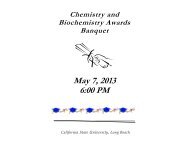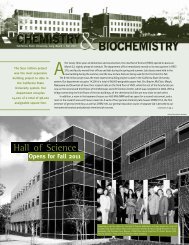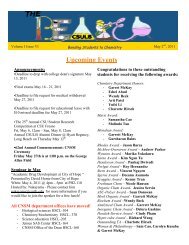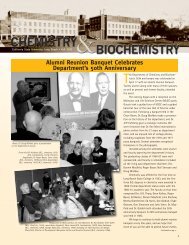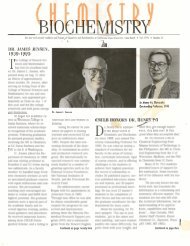2001 - California State University, Long Beach Department of ...
2001 - California State University, Long Beach Department of ...
2001 - California State University, Long Beach Department of ...
- No tags were found...
Create successful ePaper yourself
Turn your PDF publications into a flip-book with our unique Google optimized e-Paper software.
Fall <strong>2001</strong> • Number 26C 5 H 8C 5 H 8CH 4H 3 CH 2 CCatalyzed Electrocarboxylation <strong>of</strong>Alkyl Halides,” published in RecentAdvances in Electrochemistry,was co-authored by John Liarakas,a master’s student. A recent article,appearing in JACS titled,“Synthesis, X-ray Crystal Structure,and Solution Behavior <strong>of</strong>Fe(NO) 2 (1-MeIm) 2 : Implicationsfor Nitrosyl Non-heme-iron Complexeswith g = 2.03,” was coauthoredwith Dmitry Pervitsky,who received his MS degree thissummer.Dr. Li also received a Scholarlyand Creative Activities Awardfrom the university for the summer<strong>of</strong> <strong>2001</strong>.Dr. Robert LoeschenThis year has been a busy one forme, with respect to facilities. (Dr.Loeschen is associate dean incharge <strong>of</strong> physical facilities in theCollege <strong>of</strong> Natural Sciences &Mathematics.) In January we hadthe groundbreaking for the newscience building, which is locatedjust north <strong>of</strong> PH3. Since then, Imet with campus <strong>of</strong>ficials, the contractor,the project director andthe architect’s representativeevery week and listened as theydiscussed the whys and why-nots<strong>of</strong> building a science building. Thecontractor is trying to maximizepr<strong>of</strong>it (<strong>of</strong> course), but is really notworried about speed; CSULB eagerlywants the building finishedand does not want to spend thecontingency money, and the projectmanager is trying to figure outwhat everyone is doing. The resultsgive rise to some interestingdiscussions, and I am glad I amnot in charge. If everything goeson schedule, we should move inthe summer <strong>of</strong> 2003. Please planto come for a visit after the buildingis completed. Meanwhile, theshop people and I are workinghard to try to do renovations <strong>of</strong>existing space in PH1,2,3 and theMicrobiology Building because wehave so many new faculty memberswho need research space toaccommodate their needs.I have been “acting” associatedean for CNSM since 1992, andafter an exhaustive search (no oneelse applied) I was appointed tothe permanent position. It is niceto take <strong>of</strong>f the “acting” prefix.Academically, I am teaching organicchemistry and enjoying it alot. I was very honored to havebeen selected for the MayfieldTeaching Award at graduation thisyear. In the fall, I am looking forwardto teaching in the organiclaboratories, as I have not donethat for several years.Marco LopezLeaving the “Heme Team” thisyear are Alex Nunez, who wasaccepted to <strong>University</strong> <strong>of</strong> Illinois,Chicago Medical School, and JosePena, who was accepted to the UCBerkeley PhD program in Virology.Both will start fall <strong>2001</strong>. Two graduatestudents, Danny Ponce andVipal Patel, defended their master’sthesis. Danny’s thesis, “Synthesisand NMR <strong>of</strong> Tractable Models<strong>of</strong> Aqueous Heme Proteins,”was defended in summer 2000,and Vipal’s thesis, “Computer SimulatedTrajectory <strong>of</strong> a StericallyHindered CO-Heme System,” wasdefended in May <strong>2001</strong>. MS studentsJing Leng and Kian Kani arewriting their MS theses this summer.MS student Phat Hoang wrotehis thesis last year and got a job inthe Bay Area; we are waiting forhim to return and defend it. TheHeme Team will be looking to increasethe number <strong>of</strong> students.Currently, Juan Lopez, whoseproject is the characterization <strong>of</strong>NO-Heme complexes, is the only“Heme-Teamer” remaining. Wewill be looking to recruit studentsto the Heme Team this summer.Together with other faculty inthe college, we were fortunate inreceiving funding for a researchproposal titled, “Proximal Effectson Ligand Binding to HemeproteinModels,” submitted as part <strong>of</strong> aSCORE grant to the NIH. Thefunds will be used to set up ananosecond flash-photolysis lab forstudying the kinetics <strong>of</strong> ligand(O 2 , CO, and NO) binding toheme models <strong>of</strong> proteins. Furthermore,this grant will provide fundsfor a technician to help in performingthe experiments. Thefunding is for three years andstarts Sept. 30, <strong>2001</strong>.During the last year I have beengetting experience in teaching theAdvanced Organic Chemistry Laboratorycourse, Chem 420. Lastfall I “interned” Dr. Nakayama’slab section and attended Dr. Berryhill’slectures. This spring I taughta section <strong>of</strong> the course. In the fall,I will take over responsibilities forthe course. The course teaches advancedlaboratory techniques andspectroscopy, focusing on MassSpectrometry and Nuclear MagneticResonance (NMR) spectroscopy.Tom MaricichThis past year reflects the comingyear, where I will continue toteach organic chemistry lectureand lab, coordinate the lab and coordinatethe department seminarprogram. Four years ago I introducedthe teaching <strong>of</strong> Chem 320Aduring the summer session. It nowregularly draws about 50 (<strong>of</strong>tendesperate) students, who tend toperform better than those in classesduring the regular terms.My research students are makingprogress on their projects. AndreaChen is completing her master’sproject working with a chiralsulfonimidate alkylating agent shesynthesized. She has submittedcrystals <strong>of</strong> one diastereomer for X-ray analysis by one <strong>of</strong> our seminarspeakers this past semester, Dr.Katherine Kantardjieff, pr<strong>of</strong>essorand director <strong>of</strong> the W. M. KeckFoundation Center for MolecularStructure at CSU, Fullerton. Andreais hoping to demonstrateselective, chiral alkylation onracemic mixtures <strong>of</strong> chiral acidsand on meso or prochiral diacids.Another student, Dustin Wride, isbeginning to investigate the alkylation<strong>of</strong> sulfhydryl groups underacidic conditions, with potentialapplications toward alkylation <strong>of</strong>cysteine SH groups in peptides andproteins. This project was stimulatedby suggestions from Dr.Roger Acey. Mike Eagan completedhis project and graduated SummaCum Laude. He is heading formedical school at UCLA this fall.Caroline Carter worked on a summerinternship at Neutrogena inLos Angeles.This summer we travelled toAnacortes, Wash. with our two sonsand daughter, their two spousesand our three grandchildren tojoin with over 100 descendants <strong>of</strong>my parents to celebrate a memorialcentennial <strong>of</strong> my mother’s birth.While we were there, we took infour operas <strong>of</strong> “Der Ring des Nibelungen”by the Seattle Opera.Kenneth MarsiI have completed my Faculty EarlyRetirement stint, but will continueto teach the second semester <strong>of</strong>organic chemistry in the fall <strong>of</strong><strong>2001</strong>. I have an ongoing assignmentas the editor <strong>of</strong> the Chemistry &Biochemistry Newsletter and asthe Coordinator <strong>of</strong> the AdvisoryCouncil and am active in assistingDean Nagel with fundraising forthe department and College <strong>of</strong>Natural Sciences & Mathematics.In April I served as the externalreviewer for the <strong>Department</strong> <strong>of</strong>Chemistry at <strong>California</strong> <strong>State</strong> <strong>University</strong>,Hayward. Every five yearseach department in the <strong>California</strong><strong>State</strong> <strong>University</strong> System must bereviewed by an external visitor inthe discipline. I had been the reviewerin the previous cycle andon returning for my second fiveyearreview I was pleased to findthat many <strong>of</strong> my recommendationshad been implemented by the department.Dr. Leroy Chauffe, thedepartment chair at Hayward, wasa lecturer in our department during1967-1968. The year justended marked the 40th year <strong>of</strong> mymembership on the faculty at CSULB.I was privileged to have sixPresident’s Scholars in my firstsemester organic class, and I lookMolinaContinued from page 1challenges successfully met iscommunicating matters <strong>of</strong> healthto people <strong>of</strong> a variety <strong>of</strong> culturesand languages. This has been accomplishedby maintaining a workforcethat reflects the ethnic composition<strong>of</strong> its patients and byhiring staff who live in patients’neighborhoods and speak theirlanguages. Molina Healthcare is aprovider <strong>of</strong> health care to approximately350,000 persons.Nearly all the company’s revenuesderive from Medicaid andother government-sponsoredhealth insurance programs. However,customers also include stateagencies such as the <strong>California</strong><strong>Department</strong> <strong>of</strong> Health Services.According to Mario, “Othercompanies enter and exit theMedicaid market depending onhow pr<strong>of</strong>itable it is for them andhow much effort they have toexpend. It’s just the opposite forMolina Healthcare. We are in itfor the long term. We find waysto make it work.”Mario received high honorsand was elected to Phi Beta Kappawhile at CSULB.Martha, also a Phi Beta Kappagraduate <strong>of</strong> CSULB, received numerousawards during her undergraduatecareer, including theKhalil Salem Award, the ToniHoralek Award and the David L.Scoggins Scholarship. She was alsopresident <strong>of</strong> the Student Affiliates<strong>of</strong> the American Chemical Societyduring one <strong>of</strong> its most active years.Left to right: Dr. and Mrs. Robert Loeschen and Dr. and Mrs. Tom Maricich atthe 29th Annual Awards Banquet in May.See page 6, Faculty & Staff5


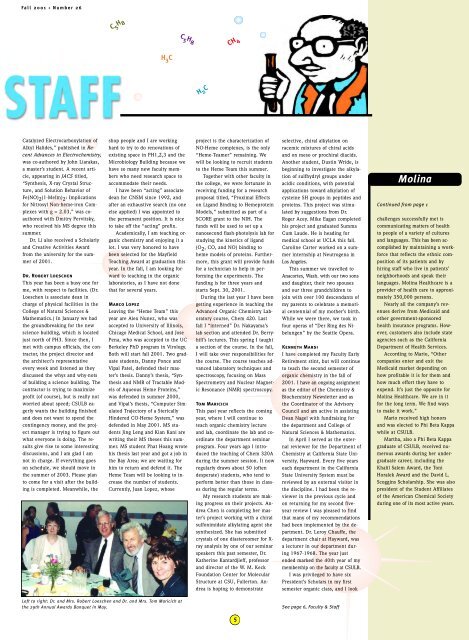
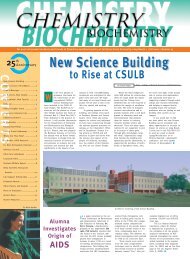
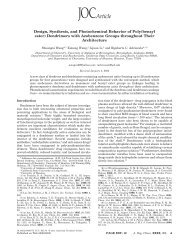
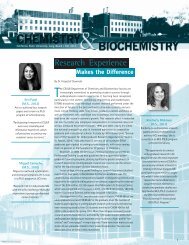
![Volume 4, Issue 3 [November 2012 pdf] - California State University ...](https://img.yumpu.com/34605825/1/190x245/volume-4-issue-3-november-2012-pdf-california-state-university-.jpg?quality=85)
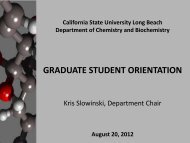
![Volume 5, Issue 2 [April 2013 pdf] - California State University, Long ...](https://img.yumpu.com/33273195/1/190x245/volume-5-issue-2-april-2013-pdf-california-state-university-long-.jpg?quality=85)
